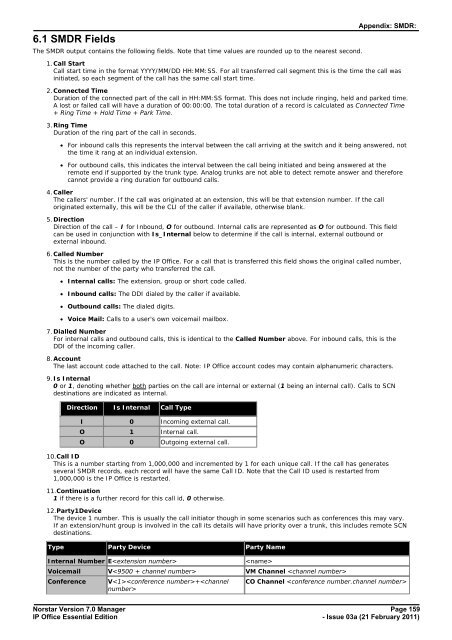Norstar Version - IP Office Info
Norstar Version - IP Office Info
Norstar Version - IP Office Info
You also want an ePaper? Increase the reach of your titles
YUMPU automatically turns print PDFs into web optimized ePapers that Google loves.
6.1 SMDR Fields<br />
The SMDR output contains the following fields. Note that time values are rounded up to the nearest second.<br />
Appendix: SMDR:<br />
1. Call Start<br />
Call start time in the format YYYY/MM/DD HH:MM:SS. For all transferred call segment this is the time the call was<br />
initiated, so each segment of the call has the same call start time.<br />
2. Connected Time<br />
Duration of the connected part of the call in HH:MM:SS format. This does not include ringing, held and parked time.<br />
A lost or failed call will have a duration of 00:00:00. The total duration of a record is calculated as Connected Time<br />
+ Ring Time + Hold Time + Park Time.<br />
3. Ring Time<br />
Duration of the ring part of the call in seconds.<br />
· For inbound calls this represents the interval between the call arriving at the switch and it being answered, not<br />
the time it rang at an individual extension.<br />
· For outbound calls, this indicates the interval between the call being initiated and being answered at the<br />
remote end if supported by the trunk type. Analog trunks are not able to detect remote answer and therefore<br />
cannot provide a ring duration for outbound calls.<br />
4. Caller<br />
The callers' number. If the call was originated at an extension, this will be that extension number. If the call<br />
originated externally, this will be the CLI of the caller if available, otherwise blank.<br />
5. Direction<br />
Direction of the call – I for Inbound, O for outbound. Internal calls are represented as O for outbound. This field<br />
can be used in conjunction with Is_Internal below to determine if the call is internal, external outbound or<br />
external inbound.<br />
6. Called Number<br />
This is the number called by the <strong>IP</strong> <strong>Office</strong>. For a call that is transferred this field shows the original called number,<br />
not the number of the party who transferred the call.<br />
· Internal calls: The extension, group or short code called.<br />
· Inbound calls: The DDI dialed by the caller if available.<br />
· Outbound calls: The dialed digits.<br />
· Voice Mail: Calls to a user's own voicemail mailbox.<br />
7. Dialled Number<br />
For internal calls and outbound calls, this is identical to the Called Number above. For inbound calls, this is the<br />
DDI of the incoming caller.<br />
8. Account<br />
The last account code attached to the call. Note: <strong>IP</strong> <strong>Office</strong> account codes may contain alphanumeric characters.<br />
9. Is Internal<br />
0 or 1, denoting whether both parties on the call are internal or external (1 being an internal call). Calls to SCN<br />
destinations are indicated as internal.<br />
Direction Is Internal Call Type<br />
I 0 Incoming external call.<br />
O 1 Internal call.<br />
O 0 Outgoing external call.<br />
10.Call ID<br />
This is a number starting from 1,000,000 and incremented by 1 for each unique call. If the call has generates<br />
several SMDR records, each record will have the same Call ID. Note that the Call ID used is restarted from<br />
1,000,000 is the <strong>IP</strong> <strong>Office</strong> is restarted.<br />
11.Continuation<br />
1 if there is a further record for this call id, 0 otherwise.<br />
12.Party1Device<br />
The device 1 number. This is usually the call initiator though in some scenarios such as conferences this may vary.<br />
If an extension/hunt group is involved in the call its details will have priority over a trunk, this includes remote SCN<br />
destinations.<br />
Type Party Device Party Name<br />
Internal Number E<br />
<br />
Voicemail V VM Channel <br />
Conference<br />
V+<br />
CO Channel <br />
<strong>Norstar</strong> <strong>Version</strong> 7.0 Manager Page 159<br />
<strong>IP</strong> <strong>Office</strong> Essential Edition<br />
- Issue 03a (21 February 2011)

















